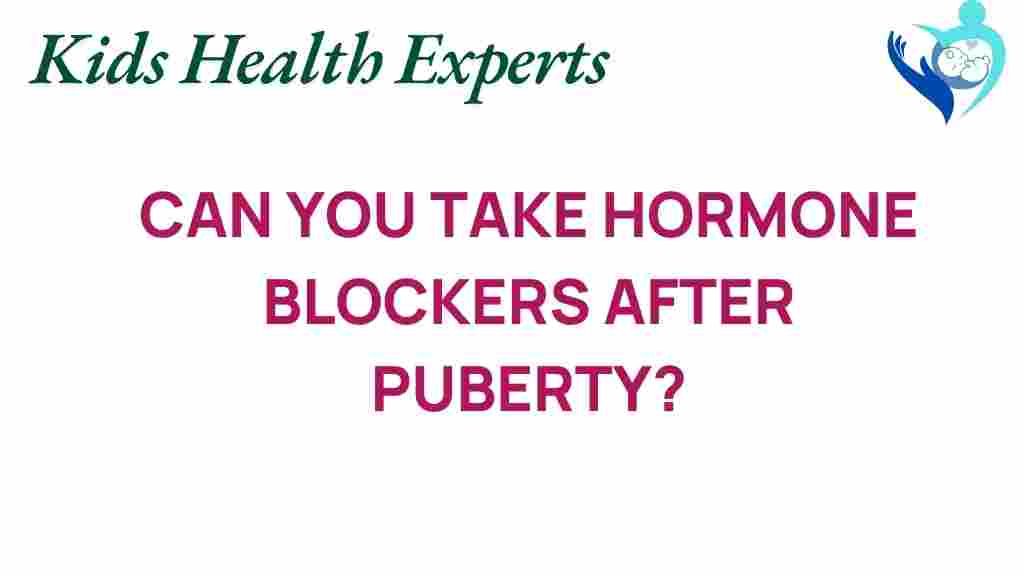Hormone Blockers: Are They an Option Post-Puberty?
In recent years, discussions surrounding hormone blockers have gained significant traction, particularly in the context of gender identity and transgender care. For many individuals, navigating the complexities of hormonal therapy and the effects of puberty can be overwhelming. This article delves into whether hormone blockers are a viable option for those who have already gone through puberty, exploring their implications on health choices and medical treatment.
Understanding Hormone Blockers
Hormone blockers, also known as puberty blockers or GnRH agonists, are medications that inhibit the body’s natural sex hormones. They are primarily used in the following contexts:
- To delay the onset of puberty in transgender youth.
- To manage certain medical conditions such as precocious puberty.
- As part of a broader treatment plan for trans individuals who are transitioning.
While their use is well-documented in pre-pubertal individuals, the question arises: can they still be effective or beneficial for those who are post-puberty? This article aims to explore that question in detail.
The Role of Hormones in Puberty
Puberty is a critical developmental stage marked by significant physical and emotional changes driven by hormones. In transgender individuals, the effects of puberty can lead to body dysphoria, which is the distress caused by a discrepancy between one’s experienced or expressed gender and their assigned sex at birth. For individuals who have undergone puberty, the irreversible changes can include:
- Development of secondary sexual characteristics (breast development, facial hair growth, etc.)
- Changes in body fat distribution
- Voice changes
- Menstruation in those assigned female at birth
Post-Puberty Options: Can Hormone Blockers Help?
Once an individual has gone through puberty, the use of hormone blockers becomes less straightforward. While they are primarily intended to prevent the onset of puberty, their capacity to reverse or significantly alter the effects of puberty in post-puberty individuals is limited. However, there are still some avenues worth exploring:
- Hormonal Therapy: Many individuals choose to undergo hormonal therapy, which typically involves the administration of estrogen or testosterone. While this does not block hormones, it can help to align secondary sexual characteristics with one’s gender identity.
- Cosmetic Procedures: For physical changes that cannot be addressed through hormonal therapy, many individuals opt for surgical procedures to help align their physical appearance with their gender identity.
- Psychological Support: Accessing therapy and support groups can provide essential emotional support as individuals navigate their feelings about their bodies and identities.
Medical Considerations for Post-Puberty Individuals
Before considering any medical treatment, including hormone blockers or hormonal therapy, individuals should consult healthcare professionals who specialize in transgender care. Important factors to consider include:
- Health History: A thorough assessment of one’s medical history is crucial for determining the best treatment options.
- Personal Goals: Understanding what an individual hopes to achieve through treatment can guide the decision-making process.
- Potential Risks: All medical treatments come with potential risks and side effects that must be weighed against the benefits.
Consulting Healthcare Professionals
For those considering hormonal therapy or other treatments post-puberty, it is essential to consult with healthcare professionals who are knowledgeable about transgender care. A multidisciplinary approach is often the best way to ensure comprehensive care. This might include:
- Endocrinologists, who specialize in hormone treatments.
- Mental health professionals, who can provide support and counseling.
- Surgeons, if surgical options are being considered.
Common Misconceptions About Hormone Blockers
There are several misconceptions regarding the use of hormone blockers and their effectiveness post-puberty:
- Myth 1: Hormone blockers can reverse all effects of puberty.
Fact: Once puberty has occurred, hormone blockers cannot reverse physical changes fully, but they can be part of a broader treatment plan. - Myth 2: Hormone blockers are dangerous and untested.
Fact: While all medications carry risks, hormone blockers have been used safely for many years in various medical contexts. - Myth 3: Hormone blockers are the only option for transgender individuals.
Fact: There are multiple pathways to support individuals in aligning their bodies with their gender identity.
Step-by-Step Process for Seeking Treatment
If you are considering options for transitioning or aligning your body with your gender identity post-puberty, here is a step-by-step process to guide you:
- Research: Start by learning about the available options for hormonal therapy and other medical treatments.
- Consultation: Schedule an appointment with a healthcare provider who specializes in transgender care.
- Assessment: Undergo a thorough assessment, including mental health evaluations and medical history reviews.
- Develop a Plan: Work with your healthcare team to develop a personalized treatment plan that aligns with your goals.
- Follow-Up: Regularly follow up with your healthcare team to monitor progress and make necessary adjustments to the treatment plan.
Troubleshooting Common Issues
As with any medical treatment, individuals may encounter challenges along the way. Here are some common issues and troubleshooting tips:
- Emotional Distress: If you experience significant emotional challenges or dysphoria, consider seeking additional counseling or support groups. Find support resources here.
- Physical Side Effects: Report any adverse physical side effects to your healthcare provider immediately so they can adjust your treatment plan if necessary.
- Access to Care: If you struggle to find knowledgeable healthcare providers, reach out to local LGBTQ+ organizations for recommendations.
Conclusion
In summary, while hormone blockers are primarily designed to prevent the effects of puberty, individuals who are post-puberty have various medical treatment options available to them. These include hormonal therapy, cosmetic procedures, and psychological support. It is crucial to approach these decisions with careful consideration, guided by healthcare professionals experienced in transgender care. Ultimately, the goal is to empower individuals to make informed health choices that align with their gender identity and personal health goals.
For more information on hormone therapy and treatment options, please check this resource.
This article is in the category Care and created by KidsHealthExperts Team
